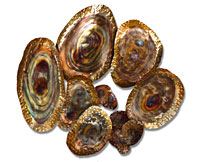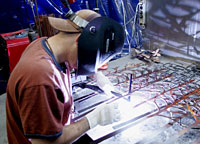Meet the Signature Copper Artists of Artist House
 Abalone Shells
Abalone ShellsPhotograph courtesy of Artisan House
When California copper jewelry maker Jerry Fels and his brother-in-law Curtis Freiler decided to start a business together, they had a vision to create original, one-of-a-kind metal art for the masses. They believed fine art should be accessible to everyone, and opened The Artisan House in 1964, a unique metal studio that transcended the traditional attitude of high art to create gallery-quality, decorative metal art at affordable prices.
Fels, who made a name for himself in the ‘40s with his successful Renoir and Matisse lines of affordable geometric copper jewelry, concentrated on creating unique designs and handling sales, while Freiler was responsible for producing their new line of sculptures. They started like many metalwork artists of the era by creating representational art such as trees, graceful branches, or birds in flight, often as wall pieces or for a table, sometimes incorporated into a lamp or a mirror. They soon broadened their vision by making more abstract designs, larger free standing works, and even some outdoor art pieces. They acquired a number of designers and craftsmen to duplicate their designs. Each piece was signed C. Jeré, an the amalgam of Fels' and Freiler's first names (Curtis and Jerry), a signature that became the trademark of Artisan House.
Though Fels and Freiler sold the company in 1972, their vision has been maintained and further expanded. Today, Artisan House employs nearly 250 people, including sales staff, customer service, quality control, warehousing, and a full stable of metal artists. The company offers a revolving catalog of more than 350 sculpture designs that are changed out twice a year as new designs are approved and added.
 Head Artist Shawn Coffey at work
Head Artist Shawn Coffey at workPhotograph courtesy of Artisan House
The 15,000 square-foot C. Jeré Design Studio in Burbank, California, is part of the larger 40,000 square foot headquarters. This studio is the hub of creative activity for their house designers who craft new ideas for the Artisan House line, using special ovens, a comprehensive finishing area, and a state-of-the-art CAD design system.
Artisan House sculptures have been installed in homes, hotels, casinos, restaurants, bars, and even as wall art for major department stores such as Nordstom's. In fact, some Artisan House works have been used as set decorations for movies and television show, including HBO's The Sopranos. In response to a growing retro trend in home furnishings, popular home décor designer Jonathan Adler recently commissioned Artisan House to reproduce some of the company's vintage 1970s sculptures, which were made mostly from brass and copper.
For more than four decades, the Artisan House has relied on the creativity of its metal sculptors to keep up with demand and develop new works of art. Artist BJ Keith, who has been with the company since 1978, started working for Artisan House while she was earning her studio art degree at California State University. Working out of her home studio in the foothills of the San Gabriel Mountains, Keith, like many Artisan House designers, has a very satisfying arrangement with the company. Though her work is anonymous, taking on the company signature, she is very happy to have a chance to make beauty for someone to enjoy and get paid for it, while having the freedom to craft her own original pieces.
“Having a nice painting or sculpture in your home just brings so much enjoyment. That makes me feel good to think that maybe I've put a smile on somebody's face,” she says. “I do mostly contemporary, non-objective pieces, and I deliberately give it a name that doesn't mean anything. I try not to make a commentary on the piece because the minute I do the person can't see it any other way than that. I want them to have their own experience with the work.”
Unlike some Artisan House designers who just bring in a drawing and have someone make up a sample, Keith happily works on her own welding bench, crafting her own prototypes. “I like doing it myself,” she says. “That element of discovery is just wonderful when you're making something.”
Keith works mostly in copper, brass, and bronze, as well as electroplated metals and steel.
 Romantic
RomanticPhotograph courtesy of Artisan House
For the copper alloys that she uses, Keith works with mild acid patinas. “They're a blue-green or black that darkens the copper,” she says. “Then you can rub it back out so that it has that rich luster to it. When you take an acetylene torch and heat copper, it turns beautiful blues and purples and golden colors.” To preserve these colors, all of the sculptures, no matter what metal, are given a clear coating, even those that are painted. “It's a more permanent protection for the piece.”
In the thirty years Keith has been making sculptures for Artisan House, she has produced a consistent product line. “Almost all of the free standing floor sculpture designs are mine. In fact, close to half the line is mine,” she says. “I probably have more sculptures in people's homes around the world than anybody alive...But it's all anonymous.”
Keith can also do original commissions or gallery work if she chose to. “I have done a few contract pieces for a couple of attorneys' offices over the years. But usually I'm so busy with Artisan House that I don't seek it out. If it comes to me, fine, but I haven't aggressively gone after that.”
One of the newest sculptors at Artisan House is Shawn Coffey, Head Artist at the C. Jeré Design Studio. Coffey started out as the well-known, Dallas graffiti artist, Sli. He was commissioned (that is, they supplied the spray paint) by area businesses who asked him and his crew to paint business-related art on their buildings to discourage gang graffiti. “When our crew painted something on a wall, gang members wouldn't generally deface it,” Coffey says. “That's high praise from the street.”
When Coffey moved back to Albuquerque, his hometown, he taught himself how to wire weld because he needed to make a gate in a wood fence he had built to keep his wandering dog home. “Being a creative person, I started to gather random scrap pieces of metal---car parts, gears, license plates, anything weldable,” he recalls. “I started putting them together and giving them away as gifts for family members.”
A new neighbor saw his work and arranged for his first show at a local bar in the hip part of Albuquerque. “I sold everything my first time out,” he admits. Coffey continued to make art and do small shows while he finished his education degree and began work as a middle school art teacher. At a show in New York 3½ years ago, a scout from Artisan House saw his work and made him an offer he couldn't refuse. He quit teaching and moved to California.
Like Keith, Coffey is permitted to create his own original works for galleries and private commissions, and he has carte blanche to work out new designs. “I will do a chicken scratch, a little sketch, so that I don't forget the basic idea,” he says. “During the building process, I may come up with one or two more ideas for pieces as I make that one design. Sometimes, it morphs into something. You never know.”
As Head Artist, he helps other designers who need help moving from their drawings to a finished prototype, and also helps choose the final selections in the design review process.
“Some artists we have at Artisan House contribute designs, but they aren't welders. I will weld it or make it for them. We have craftsmen here who do that as well, and I'll supervise the process.”
When Coffey first came to Artisan House, he did colorful painted floor sculptures, wall designs, and tabletop pieces. “Right now, I'm starting to use a lot of brass and copper because I'm seeing an art work trend going toward retro,” he says. “Even if I make the base or the armature out of regular steel, I'll add copper and brass elements with a flame treatment or a patina finish, just to achieve that vintage look.”
Coffey shapes, welds, and heat treats sheet copper and copper tubing into his designs. He's especially fond of the colors that heated copper can produce. “The rainbow colors are absolutely amazing when you put a flame to it. I don't even think I could match, mixing paint, the colors that you can achieve putting flame to a piece of solid copper.”
Resources:
Also in this Issue:
- Meet the Signature Copper Artists of Artist House
- J Crocker Designs: Shedding an Eco Friendly Light on Copper
- Roland Hockett: Experiments with Copper
- The Wurlitzer Brass Pipe Organ Revival at the City Museum
- Bronze by Barye on Exhibit at MIA
